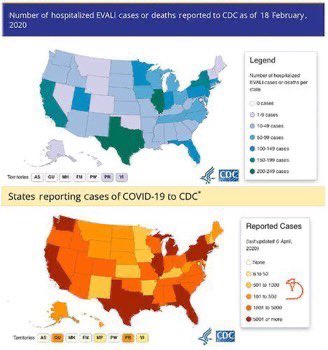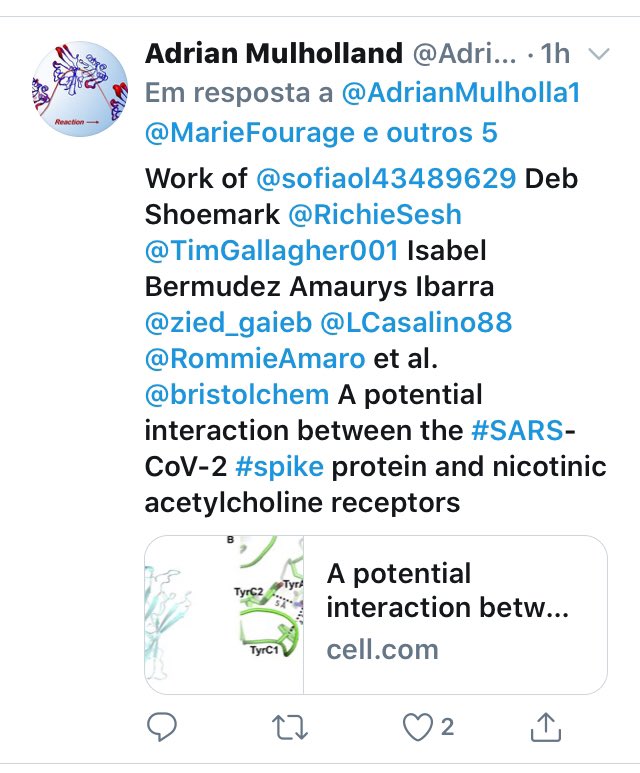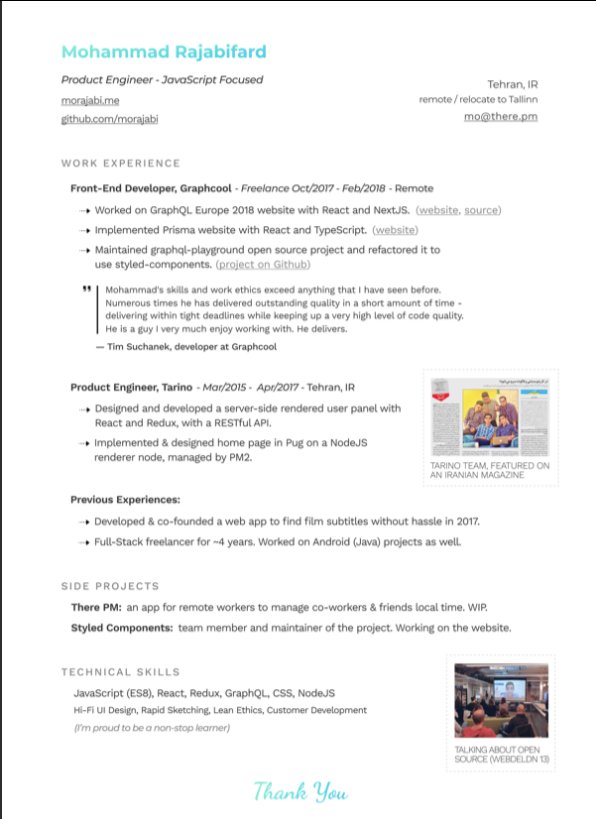👉 “SARS-CoV-2 spike protein may interact with nicotinic acetylcholine receptors (nAChRs), & that such interactions may be involved in pathology & infectivity.” 👉👉👉👉 EVALI 👉 COVID-19 👇https://t.co/cCdTJiZzQZ

\u201cNo one substance has been identified in all of the samples tested. Importantly, identifying any compounds that are present in the samples will be one piece of the puzzle but will not necessarily answer questions about what is causing these illnesses.\u201d https://t.co/97UpfKIOqY
— Renaissance Man (@2dedostesta) September 10, 2020
\U0001f449 \u201cSARS-CoV-2 spike protein may interact with nicotinic acetylcholine receptors (nAChRs), & that such interactions may be involved in pathology & infectivity.\u201d \U0001f449\U0001f449\U0001f449\U0001f449 EVALI \U0001f449 COVID-19 \U0001f447https://t.co/cCdTJiZzQZ pic.twitter.com/Vc8lwKCuH8
— Covid Fact Check \u270c\ufe0f (@2dedostesta2) February 24, 2021

2019 \U0001f449 EVALI was COVID-19 \U0001f449 Imaging of Vaping-Associated Lung Disease \U0001f449 https://t.co/zn0Er2Z3va \U0001f449 Detection of COVID-19 using CXR and CT images \U0001f449 https://t.co/w7wZBGRnvL https://t.co/nSCE1F61vP pic.twitter.com/UkMJu5iyW4
— qwert (@qwert03118543) January 27, 2021

\U0001f449 on Dec 13th 2019 \U0001f1fa\U0001f1f8 had > than 6 MILLION people with SARS-COV-2 antibodies \U0001f449 2%\u203c\ufe0f\U0001f447
— Covid Fact Check \u270c\ufe0f (@2dedostesta2) February 25, 2021
https://t.co/mHJnt2Nnjm
👉These findings suggest that 👉SARS-CoV-2 may have been introduced into the 🇺🇸 👉prior to January 19, 2020‼️
👉 2016 👉 PULITZER ‼️


SARS-CoV-2 through nAChRs may dysregulate the cholinergic anti-inflammatory pathway.
Interaction of SARS-CoV-2 Spike with nAChRs is due to a “toxin-like” sequence. https://t.co/oVGkoKIPKp


“the RBD (...) interact with TCRs.”
“the same segment bears close similarity to the HIV-1 glycoprotein gp120 SAg motif F164 to V174.” https://t.co/zqGd8m28mM
“possible that a poor initial antibody response to the virus fails to neutralize the SAg, as recently shown in MIS-C patients, leading to immune enhancement following reexposure.”
“potential genetic component to susceptibility.”
Can I get my Pulitzer now ❓
Latency ❓ Pulitzer ❓
\u201chigh propensity of the SARS-CoV-2 S TCRV\u03b2-binding site residues potentially elicit an SAg-like response.\u201d
— Covid Fact Check \u270c\ufe0f (@2dedostesta2) March 6, 2021
\u201cthe RBD (...) interact with TCRs.\u201d
\u201cthe same segment bears close similarity to the HIV-1 glycoprotein gp120 SAg motif F164 to V174.\u201d https://t.co/zqGd8m28mM
to dissect the immunopathology of inflammatory diseases.” 👇https://t.co/cLuJYLUUyk

\U0001f449 \u201cSARS-CoV-2 spike protein may interact with nicotinic acetylcholine receptors (nAChRs), & that such interactions may be involved in pathology & infectivity.\u201d \U0001f449\U0001f449\U0001f449\U0001f449 EVALI \U0001f449 COVID-19 \U0001f447https://t.co/cCdTJiZzQZ pic.twitter.com/Vc8lwKCuH8
— Covid Fact Check \u270c\ufe0f (@2dedostesta2) February 24, 2021
You May Also Like
- Forget what you don't have, make your strength bold
- Pick one work experience and explain what you did in detail w/ bullet points
- Write it towards the role you apply
- Give social proof
/thread

"But I got no work experience..."
Make a open source lib, make a small side project for yourself, do freelance work, ask friends to work with them, no friends? Find friends on Github, and Twitter.
Bonus points:
- Show you care about the company: I used the company's brand font and gradient for in the resume for my name and "Thank You" note.
- Don't list 15 things and libraries you worked with, pick the most related ones to the role you're applying.
-🙅♂️"copy cover letter"
"I got no firends, no work"
One practical way is to reach out to conferences and offer to make their website for free. But make sure to do it good. You'll get:
- a project for portfolio
- new friends
- work experience
- learnt new stuff
- new thing for Twitter bio
If you don't even have the skills yet, why not try your chance for @LambdaSchool? No? @freeCodeCamp. Still not? Pick something from here and learn https://t.co/7NPS1zbLTi
You'll feel very overwhelmed, no escape, just acknowledge it and keep pushing.
Ironies of Luck https://t.co/5BPWGbAxFi
— Morgan Housel (@morganhousel) March 14, 2018
"Luck is the flip side of risk. They are mirrored cousins, driven by the same thing: You are one person in a 7 billion player game, and the accidental impact of other people\u2019s actions can be more consequential than your own."
I’ve always felt that the luckiest people I know had a talent for recognizing circumstances, not of their own making, that were conducive to a favorable outcome and their ability to quickly take advantage of them.
In other words, dumb luck was just that, it required no awareness on the person’s part, whereas “smart” luck involved awareness followed by action before the circumstances changed.
So, was I “lucky” to be born when I was—nothing I had any control over—and that I came of age just as huge databases and computers were advancing to the point where I could use those tools to write “What Works on Wall Street?” Absolutely.
Was I lucky to start my stock market investments near the peak of interest rates which allowed me to spend the majority of my adult life in a falling rate environment? Yup.











